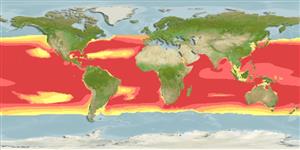Environment: milieu / climate zone / depth range / distribution range
Ecology
Marine; bathypelagic; oceanodromous (Ref. 51243); depth range 40 - 750 m (Ref. 4479). Deep-water; 48°N - 48°S, 180°W - 180°E
Eastern Atlantic: Mauritania to Angola. Western Atlantic: USA to Brazil, with extensions to Argentina. Northwest Atlantic: Canada (Ref. 5951). Indian Ocean: between 10°N and 30°S. Pacific Ocean: between 30°N and 25°S (Ref. 4066); New Zealand (Ref. 5755).
Length at first maturity / Size / Weight / Age
Maturity: Lm 5.4 range ? - ? cm
Max length : 7.3 cm SL male/unsexed; (Ref. 4479); max. published weight: 5.50 g (Ref. 126117)
High-oceanic species (Ref. 4066). Found between 425-750 m during the day and at 40-500 m at night, with maximum abundance at 75 m (Ref. 4479). Mesopelagic (Ref. 58302). Specimens reach sexual maturity at a length of 5.4 cm. Off southern Brazil found between 500-900 m during the day and 25-300 m at night. (Ref. 47377).
Life cycle and mating behavior
Maturities | Reproduction | Spawnings | Egg(s) | Fecundities | Larvae
Hulley, P.A., 1990. Myctophidae. p. 398-467. In J.C. Quero, J.C. Hureau, C. Karrer, A. Post and L. Saldanha (eds.) Check-list of the fishes of the eastern tropical Atlantic (CLOFETA). JNICT, Lisbon; SEI; Paris; and UNESCO, Paris. Vol. 1. (Ref. 4479)
IUCN Red List Status (Ref. 130435)
Threat to humans
Harmless
Human uses
Tools
Special reports
Download XML
Internet sources
Estimates based on models
Preferred temperature (Ref.
123201): 9.9 - 21.7, mean 14.6 °C (based on 980 cells).
Phylogenetic diversity index (Ref.
82804): PD
50 = 0.5078 [Uniqueness, from 0.5 = low to 2.0 = high].
Bayesian length-weight: a=0.01000 (0.00492 - 0.02031), b=3.06 (2.87 - 3.25), in cm total length, based on LWR estimates for this species & (Sub)family-body (Ref.
93245).
Trophic level (Ref.
69278): 3.0 ±0.00 se; based on food items.
Resilience (Ref.
120179): High, minimum population doubling time less than 15 months (Preliminary K or Fecundity.).
Fishing Vulnerability (Ref.
59153): Low vulnerability (10 of 100).
